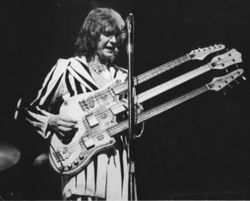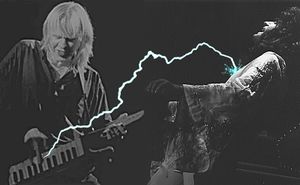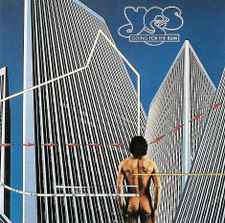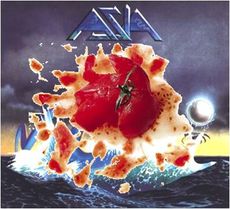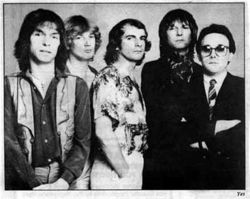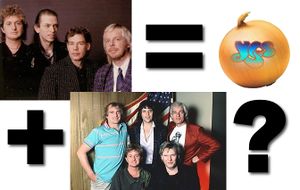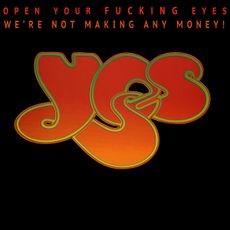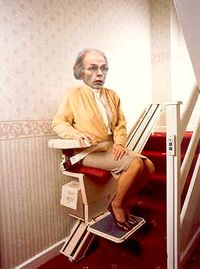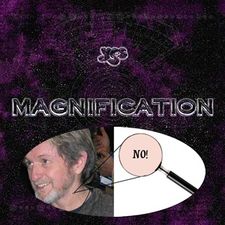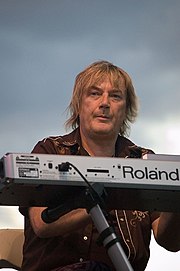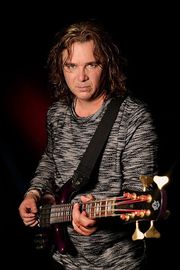Yes (band)
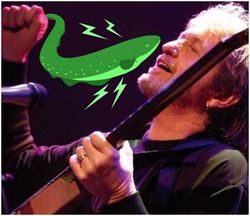
“Going for the one!”
Yes is an immensely significant and universally-recognised English progressive rock band that formed in London in 1968, after an unsuccessful career as a word in the English dictionary. This relatively unknown incarnation of Yes failed because such a word is entirely unnecessary, and was seen by many as over-the-top and self-indulgent.
Yes music relies heavily on the use of dynamic and harmonic variation, and often incorporates time signatures that are yet to be mathematically proved. The band are also known for their extended song lengths, incomprehensible lyrics, and general showing-off. Their unique style of blending symphonic/classical structures with their own brand of cacophonous musical tomfoolery has been described by many as over-the-top and self-indulgent. Despite daily lineup changes, warfare within the group, and the ever-changing trends in popular music, the band has continued on for over fifty years and still retains a large following.
Early YesYears
The Origins

Since the release of The Beatles' Corporal Salt's Only Darts Club Bandana and the invention of progressive rock, being popular was seen as unfashionable. A new generation of musicians, under strict orders from Lucy in the Sky, began creating very aurally-demanding music, which was for some reason described as progressive. Yes was no exception.
In 1968, Jon Anderson (vocalist, washboard player, whale-poacher, part-time midget, missing 'h') met Chris Squire (bassist, tall guy, fish, Schindleria praematurus; had been expelled from school for having too much hair) in an underground London khatru filled with astral travellers and starship troopers, and the pair soon discovered they shared an interest in psychedelic noodling. Squire played in Mabel Greer's Toyshop, a jazz-influenced cover band that also featured lead vocalist/sometimes-guitarist Clive Bayley; drummer Bob Hagger; and a remarkably unimportant other-guitarist. Squire asked Anderson if he wanted to join, to which Anderson replied "Yes"; the band's name was changed accordingly.
A new lineup was then formed, with the sackings of Bayley and Hagger, and the additions of Tony Kaye, a young pianist with a phobia of the Mellotron; and Bill Bruford, a man with completely unsynchronised perceptions of rhythm, making jazz drumming the only realistic career choice. At one point, Bruford left Yes to go to college and was replaced by Tony O'Reilly, formerly of the Koopas. When the O'Reilly Factor was not working for the band's sound, as O'Reilly's drinking problems hindered his drumming, they replaced him with Ian Wallace. Bruford, who had been told by professors that his coursework was abysmal and that he would have much better luck in Earthworks, returned to Yes and replaced Wallace.
The early days in the studio were tough times for Yes. After eight months spent trying to write music, Anderson realised he didn't have a pen. As a result of this, a method of recording was developed called "sound-chasing", where the five members (except for Bruford, who didn't have a sound-chasing warrant because he wasn't a musician) would long-distance-run around the studio, chasing after the reverberations of whoever was recording next door, and try to capture the sounds in a bucket. Of course this didn't work, as they were using the wrong kind of bucket. Jimmy Page on the other hand, had a particularly good bucket, and was able to build an entire career out of other people's songs.
Yes
In 1969, Yes released Yes. The imaginatively-titled debut was a huge success for the band, compared to previous albums. This album fails to capture what is now recognised as the classic Yes sound, but fans of the band (many of whom have hearing difficulties) insist that this early period is often overlooked amongst Yes's later efforts, especially as the running time of the entire album is shorter than the average later Yes song. Tony Kaye refused to play anything but his Hammond C3 organ during these early stages, due to his alleged fear of other keyboard instruments (known formally as Claviphobia); however, this was possibly an excuse for the production budgets the band were given at the time, which only allowed for one keyboard.
Time and a Wørd
“No opportunity necessary, no experience needed.”
Soon afterwards the orchestral Time and a Wørd was released in 1970, with a similar reception. "That guitarist" was present during these sessions, although the addition of an orchestra — conducted by Beatles cover singer Tony Cox and his Royal College of Music lads — created tensions, as they were stealing all of his parts. Producer Tony Colton mixed the album while wearing a pair of faulty tin can headphones, and pushed the orchestra too high in the mix. Aggravated, the guitarist decided enough was enough, and began throwing khatrus at the other band members. Anderson eventually made the effort to learn the guitarist's name so he could fire him formally: Peter Banks was promptly kicked out of Yes, and went on to pursue a career in the superhero prog band Flash. He was then fired by frontman Barry Allen for having no talent. This at first wasn't an issue when Banks was later approached by Genesis and became their keyboard player, though he was soon replaced by his younger brother Tony.
Classic era
Howe joins the fray
Upon entering the '70s, Yes were confronted by Atlantic Records and told to come up with an album that a) didn't cost the record company thousands of pounds in plagiarism repayments, and b) had some accessible material on it. If they didn't, Atlantic would hire terrorists to assassinate each member of the band using their respective instrument (in the case of Jon, this meant using trained elves to produce shrill high-pitched sounds that would make his eardrums pop). Having taken this on board, the band hired Steve Howe, who had just retired from being the Machine Messiah, as their new guitarist. The world-famous Howe sacrificed his popularity to join Yes, and together the new lineup began to create some very accessible 10-to-25-minute songs. Since Yes wanted people to forget about Peter Banks, Howe agreed to appear on the US cover of Time and a Wørd and in the promo videos for the album. This caused newcomer fans to believe that Howe was the first (and, at that time, only) Yes guitarist.
Howe's arrival on a UFO led to a new Yes sound, whilst his ability to clap jeopardised Bill Bruford's position as occasional drum-hitter. Howe couldn't decide if he wanted to play jazz, rock, or classical music, and he couldn't choose between lead and rhythm guitar, so he decided to play them all at once. Furthermore, his tendency on stage to lapse into five-hour guitar solos gave the other members a welcome break. Jon in particular harnessed this free time by meditating backstage, and achieved enlightenment every night. After an entire tour of this however, he claimed to be so bored with it that he went away and wrote some lyrics warning Buddhists that it "just isn't what it's cracked up to be"; these musings would resurface in the song "Close to the Edge".
The Yes Albatross
Released in early 1971, The Yes Albatross was regarded as the band's first step into the world of all things progressive — not only progressive music, but also progressive stage shows, progressive album art, and progressive hair. Eddy Offord, who had previously only engineered on Time and a Wørd, was promoted to producer when he offord new sounds for Yes to use. The album mostly consisted of studio tracks, but also featured a live piece, "Clap", performed by Steve Howe on his acoustic guitar at the Lyceum Theatre, London. This solo piece was actually a direct instruction to the audience, which when disobeyed, resulted in Steve being in a bad mood for the rest of the day. Howe also lost his shit when Jon Anderson mispronounced the solo's title as "The Clap" instead of "Clap" in its introduction. The album is also known for chronicling Yes's first extended song, "Yours Has Been Replaced", which was dedicated to all the past (and future) Yes members who would be bullied out of the band. A song with similar themes was "Perpetual Change", about the band's perpetual lineup changes.
Yes's tour with Iron Butterfly (during which they stole the band's equipment after they broke up) was followed by their first American tour, during which they shared the bill with Jethro Tull (a band led by Jon's flautist brother Ian Anderson). Tony Kaye didn't twig until halfway through a live performance of "Yours Has Been Replaced", where he realised that he was Yes's next intended victim. Mid-song, he clambered out of his maximum-security keyboard corner, tried and failed to insert Squire's bass into Squire, screamed "Silly human race!", and ran out of the fire escape in search of a Mellotron-free life. He then resided in Siberia, unaware that the Khatrus were (and still are) plotting his assassination as we speak.
Fragile
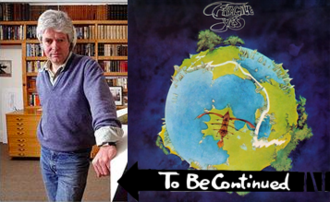
“Straight light searching all the meanings of the song.”
After the departure of Tony Kaye, Squire, who had gained a reputation as the one who was always late to rehearsal, called up strawb-eating can-collecting Brahms-influenced keyboard wizard Rick Wakeman, late at night around 2:45 A.M. (a few hours before the keyboardist had to wake up at 6 A.M. for a jingle session). Chris asked Rick if he wanted to join Yes, on the condition that he become a vegetarian; Wakeman, who had been searching for life on Mars with David Bowie and his Spiders, told Squire that he was sick of eating strawbs and hung up. Later that morning, manager Brian Lane called Wakeman again and bribed him with frozen chicken tikka masala and beer money; Wakeman finally budged and joined Yes.
In late 1971, Fragile (aka: the one with that JoJo's Bizarre Adventure meme song on it that some people have actually heard of, but not very many, and even they can't remember what it's called) was released. This album would contain some of Yes's most well-known works, such as "Roundabout", which was the band's second radio hit (the first had resulted in the breaking of a fragile radio). Alien-landscape painter Roger Dean, who created the album's cover depicting a fragile James Cameron-esque planet, also began his partnership with the band here. New keyboardist Rick Wakeman provided some unnecessarily fast keyboard runs and unnecessarily blonde hair on the album; unfortunately he suffered from "I Must Play as Many Different Keyboard Instruments as Is Physically Possible During This Song" disorder, the exact opposite of what Kaye had. This further defined the Yes sound, which was now more progressive than evolution itself.
A shortage of prog material led to the decision that each band member should contribute a solo piece to Fragile. The prospect of five songs that would theoretically be only 1/5th as progressive as the other pieces on the album was promising for the record company, but it appeared that the band had gone from one extreme to another. In particular, Bill Bruford's "Five Per Cent for Nothing" (also called "Five Pence for Production" or "37 Seconds of Nonsense") has been known to provoke seizures amongst listeners, even those who actually LIKE progressive music.
Close to the Edge
After another tour and a month or five in the studio chasing sounds, Yes unveiled their 1972 masterpiece, Close to the Edge. This album famously took a long time to release due to creative differences within the band. Jon Anderson had written some lyrics about Siddhartha's struggle against enlightenment, but when he asked the other band members to contribute music, none of them were particularly interested. Steve Howe was busy interviewing a goldfish for inspiration (see Tales from Topographic Oceans), whilst Chris Squire, the only other creative force in the band, had gone on holiday to Siberia (where he inadvertently killed an entire population of Khatrus by playing his bass well). Wakeman and Bruford spent most of the sessions eating curries and discussing the meaning of life, which made them both very depressed.
Meanwhile, Anderson completed all of the music to Close to the Edge by recording the nature sounds made down at the end, round by the corner, close to the edge, just by a river in Lothlórien, the Middle-earth forest where he was born, as seasons passed him by and he got up and down repeatedly. This resulted in a challenging album, but one which was ultimately praised by fans of prog rock for its innovation and originality. The lyrical additions made by mutant enemies were particularly well-received, allowing listeners to finally make sense of Anderson's complex wordings.
Bruford's belief that the band had peaked, with nowhere else to go from there but down, led to his eventual departure, as he was far too pessimistic to be in a band called Yes. He later joined King Simply Crimson, an ultra-progressive progressive rock band that harnessed his negativity in their song-writing. His sights were set on replacing Ian Wallace again for the Crimson album Lark's Tongue's an Asspick, and he also briefly toured for Genesis, where he would meet Peter Banks's brother Tony. Bruford was replaced in Yes by former Plastic Ono Band drummer Alan White and has since written an autobiography, which is filled entirely with witty comments regarding his awful time in the band.
“Five percent for nothing...”
Yessongs
“The spacebar broke.”
Ultra-progressive era
Tales from Topographic Oceans
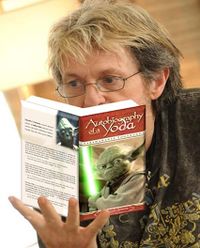
Whilst working on Yessongs, Jon Anderson read the book Autobiography of a Yoda, and during one evening of the tour, he created Tales from Topographic Oceans, an hour and twenty minutes of lyrical prog heaven. The four ambitious pieces featured on the double-album, each one lasting longer than a papal election, contain some of the most controversial lyrics in the history of everything. After limited success interrogating the goldfish, Steve Howe decided to add music, completing the mega-project. Each 20-minute suite was based on a different fish-related spiritual path.
The album has been criticised as an example of the worst excesses of prog rock. Though Howe and Squire wanted to record in the city, Anderson and Wakeman preferred the countryside (Anderson was worried about feeling lost in the city); White had no preference, probably due to his lack of personality. They went to Morgan Studios and tricked Jon into believing that they were in the countryside by adding haystacks, white picket fences, a small barn, and a model cow with electronic udders (the latter of which would inspire the lyric "electric freedom" on the Relayer song "Sound Chaser"). The hay caused Wakeman's keyboards, cape, and long golden hair to be infested with lice; it is believed that this is one reason he did not enjoy making the album.
Drastic measures were taken to ensure that the creation process was of maximum quality; no musical stone was left untouched. For example, the entire studio was at one point completely submerged underwater at a monumental cost, to allow the band members more breathing space. Wakeman would often find excuses for not being at the sessions, saying that he was recording on the Black Sabbath album Sabbath Bloody Sabbath next door (Wakeman was really just sneak-eating curry). In an attempt to counter Wakeman's decreasing enthusiasm for the project, Anderson ordered for the construction of an en-suite brewery, which itself only lured the keyboard player back in for enough time to complete the first song. The rest of the album was recorded in a bathroom, in which Squire spent all of his time swimming in the bathtub. The album was known under the working title Marmite:
“Marmite is one of those foods that everybody either loves or hates, but in reality most people hate it. Our album was like that.”
“I fucking hated it.”
“It does go on a bit.”
“Dawn of light lying between
A silence and sold sources
Chased amid fusions of wonder
In moments hardly seen forgotten...”
“We must have wasted all our lives on this moment moment moment.”
Released in 1973, the album was preordered in bulk, a move that was regretted later by both casual and hardcore fans. Being predominantly made up of land-based mammals, Yes listeners were unable to connect with the amphibiously-themed material. But Tales had reached number one on the UK and US charts before such issues were realised, resulting in a further stream of rock excess, this time financially. Not only were Yes on the verge of bankruptcy after consuming all the Earth's oil resources for their gargantuanly-proportioned plastic stage scenery, but they had also succeeded in draining the entire Atlantic Ocean of fish for their portable stage-aquariums and indulgent dietary habits. Roger Dean's sleeve design was also criticised for being geographically incorrect; the cover depicted Brimham Rocks, the last rocks at Land's End, the Logan Rock at Treen, single stones from Avebury and Stonehenge, the Mayan temple at Chichen Itza, and markings from the plains of Nazca.
During the tour for Topographic Oceans, "The Remembering Capacity of a Goldfish" was dropped from the setlist because the band could remember no more than three seconds of the song. After doing a live reading of Jules Verne's Journey to the Centre of the Earth, Rick Wakeman was discovered eating a chicken tikka masala and downing pints of beer halfway through "The Revealing Science of Cod", a strictly fish-orientated song. The other band members, all devout vegetarians, were highly offended by this blasphemous act, especially as it ruined the atmosphere of Howe's spiritual cod-summoning guitar solo. Wakeman was promptly fired, and the rest of the band finished the song.
Relayer
Following another successful tour and with Swiss keyboard-slapper Patrick Moraz on board, Yes set to work on 1974's Relayer, an album themed around war, sound chasing, and war. Though fans would assume that the title referred to a style of architecture depicted by Roger Dean on the sleeve design, it actually referred to a type of radio transmitter. Communication with Moraz was difficult because, through choice, he only spoke Swiss and Mainhorse, causing him to misunderstand the album title as a demand for him to relayer his keyboards by stacking them.
Yes masterwork "The Gates of Delirium" chronicles the then-ongoing battle that waged between Yes and their arch-nemesis Delirium, a hugely successful and talented pop group from a parallel universe. This band was memorable for their short, accessible songs, simple lyrics, and nobody ever getting fired. In contrast, this new Yes song lasted longer than the entire Holocaust and can be distinctly split into three main sections. Part 1 is the prelude, and describes the opposing Yes and Delirium forces gearing up for war. Part 2, the instrumental battle section, is the most hectic piece of music in existence (other than "Manic Monday", which is just wild); this section is in fact, so excruciatingly grotesque and full of gore, that 42 individuals have actually died of repulse listening to it, including one man who played it at full volume and simply exploded. Part 3, ""Sued", was released as a single to promote Yes winning the completely metaphorical war and suing Delirium for plagiarism.
Solo albums
Following the relayse of Relayer, the five Yes members temporarily went their separate ways. To fill the gap between Yes albums, Altantic Records released the deceptively-titled Yesterdays, on which Roger Dean butchered reimagined the sleeve design for Time and a Wørd. Though fans initially believed that the songs would be new material literally recorded yesterday, the album was actually a compilation of rehashed songs from Yes's first two albums that had been forgotten, as well as an overblown cover of Simon & Garfunkel's "America".
During their hiatus, the Yesmen released solo albums, each one a concept album about one member's hatred for another (coincidentally, four of these were aimed at Jon Anderson). This fractured career move resulted in rumours of a band breakup, forcing the group to tour together with an understandably awkward setlist featuring the respective rants of each member. Soon afterwards, Patrick Moraz (who had titled his solo album I, since it was the only English word that he knew) began to feel isolated due to the persistent language barrier between him and his bandmates, to the point where he could no longer control his hairstyle. Keen to replace the unreliable keyboard player, Anderson contacted Vangelis, but was even more disappointed when the Greek New Ager turned him down (due to conflicts with Yes touring dates and his strict weight-loss programme).
Meanwhile, Nordic god of thunder Rick Wakeman (who frequently visited his hammersmith) was now a bum after wasting his money drinking so much that he felt no earthly connection, ice-skating with Monty Python's Graham Chapman (who was dressed as King Arthur, with the other Pythons being the Knights of the Round Table Who Say Ni), journeying to the centre of the Earth, and dating the six wives of Henry VIII. These actions were added to Rick Wakeman's Criminal Record in 1977. It was also around this time that Wakeman recorded the soundtrack for White Rock, a documentary about Alan White playing drums as he competed in the 1976 Winter Olympics in Austria. Afterward, the two of them grew closer, temporarily fusing into saxophone player Alan Wakeman and appearing briefly on the Soft Machine album Softs. Then, in a strike of luck, Rick made himself available to Yes once more...
Wakeman Returns from the Centre of the Earth
Going for the One
After Wakeman kindly removed Patrick Moraz from the picture (making him look like Swiss cheese in the process), Yes tempted him back into the band with unlimited cans and progressive Brahms. To Rick's surprise, manager Brian Lane had already told Melody Maker that he was back in Yes, and they were "Gettin' the classic band back together." Anderson also apologised to Wakeman about Tales from Topographic Oceans, saying that the verses he sang did not add much weight to the wondrous stories in his head (the singles "Going for the One" and "Wondrous Stories" would include these as punchlines).
The band then parachuted into Switzerland to dodge taxes, record a new album, and stomp on Moraz's grave. These sessions were famously tough on Yes, who worked so hard that they only managed to fit in seven hours of skiing each day. Steve Howe in particular felt uneasy about Wakeman's return, and turned to transcendental meditation for stress relief. The music on 1977's Going for the One was as excessive as before though, with a real church organ being used on the epic track "Awakeman". This was sent down a phone line back to the studio, but Anderson said that the quality was terrible. The Swiss government were so offended that the entire country's phone lines were uprooted (thus turning off the 20th century momentarily) and subsequently improved. The enormous cost of this venture was then confirmed unnecessary when Anderson revealed he was actually talking about the quality of Wakeman's keyboard playing, not the quality of the phone line.
“This is the same guy that wrote fucking Tales from Topographic Oceans! How he can criticise my "blindfolded key-spanking technique" I do not know.”
Though Roger Dean had previous experience painting nude people on the cover of Yesterdays, Yes were Hipgnotised by Brian Lane to fire Dean and hire a generic art design group for GTFO GFTO to save money, resulting in their ugliest album cover yet. Going for the One was a commercial success, going for the #1 on the UK Albums Chart, and was praised by fans for paring down the bloated 20-minute epics and bonkers experimentation of the previous two albums and returning to simpler, more accessible 15-minute epics à la The Yes Album.
What followed was a series of unimportant Yes recordings that nobody knows a lot about.
Tormato
1978's Tormato began the slow path of commercial decline for Yes, selling poorly because of a new wave of punk and disco bands such as Punk Floyd and Led Synthesiser, who were beginning to dominate the music scene. The album's working title had been Yes Tor, until Wakeman angrily threw a tomato at the cover art. The single "Don't Kill the Whale" (later renamed "Don't Kill Any Sea-Dwelling Mammals" due to legal threats) was Yes's attempt to show people that they cared about the environment and become more popular with the public, who still thought "Yes" was just a word in the dictionary. The other tracks were unmemorable however; the gritty, threatening track "Circus of Heaven" is best forgotten since it features Jon's creepy son Damion "The Omen" Thorn Anderson, rambling about clowns, tigers, lions, bears, candy-floss, and toffee apples. Songwriting disputes had become more frequent and very little worthy material ended up on the record, which was dominated by Wakeman's cheesy-sounding new keyboards such as the unreliable Birotron and the untrustworthy Polymoog.
Approximately three people listened to Domo Arigato Mr. Tormato upon its release, release, and it is generally believed that two of these people were Atlantic record executives (who were locked in a room with a whale and forced to listen to it on loop for a year). Few people attended the "in the round" live shows at which Yes performed on a spinning stage, and those who did attend were only there for the complementary tomato juice. Such a small audience cast doubts on Yes's future, doubts that would only be exacerbated in the coming years.
Paris sessions
From 1979 to 1980, Yes convened in Paris, France to attempt at recording new material, during which producer Roy Thomas Baker (of Queen and The Cars fame) baked cake for the band. These sessions were notoriously splintering on the band; Anderson and Wakeman wanted to continue making fruity hippy-dippy music à la Tormato, while Howe, Squire, and White preferred a heavier, more forward-thinking new wave sound. The Paris sessions were abruptly halted on the worst Christmas ever, where Alan White broke his foot while rollerskating at a roller disco.
When the band resumed work months later, Jon Anderson famously threw away his dreams, got in a white car, drove out of the Yes roundabout to give the others a break, and began recording with his bitch Vangelis. At the risk of struggling against the cost of living once again, Rick Wakeman also resigned from Yes (again), deciding to only be a member of the band every other Wednesday. However, this departure was one of many that year week, so nobody thought much of it. What shocked the band more was Anderson himself deciding to leave, creating a massive gap in the Yes sound, and a subsequently larger gap in the Yes bank account.
Desperate times called for desperate measures, and replacement Yes members were soon found, next door.
The Bes Yeggles
Drama
When the shoes of two key Yes elements were filled in 1980 by Trevor Horn and Geoff Downes (formally of Buggles fame, and before that a comedy duo), all the remaining members could do was accept the seemingly random change. Downes was commended for his humorous anecdotes, about meeting a leopard-like running woman who used one of Roger Dean's landscapes to hide herself, but his keyboard playing left a lot to be desired. In fact, the immensely-superior guitar playing of Steve Howe (whom Downes had described as a "Machine Messiah" for his godly rapidfire playing) caused problems for Geoff; his brain could not cope with progressive rock. Together the Bes Yeggles recorded their new album Drama, which featured a rather unexpected dark tone and heavy metal-esque riffs, as opposed to the quirky feminine pop you'd expect from Buggles alumni. The music video for the single "Into the Lens" is notable for being a recording of the band's reflection in a mirror (Trevor Horn was a camera).
About halfway through the Drama tour, Downes's hands fell off against his will, leaving him unable to play. As a result, he left the band, forcing his comedy partner Horn, who had been booed by American audiences for not sounding exactly like Jon Anderson, to leave as well. As if this wasn't bad enough, Steve Howe asked himself, "Have we really got to go through this?" When nobody answered to "Yes", he then decided to leave on his birthday, as he had won a scratch-card holiday to Asia. Now only two members remained, the omnipresent Chris Squire and his sidekick Alan White, who due to his lack of a personality, followed the bass player around non-stop. By 1981, the band's management had announced that Yes was no more. Squire was irritated at the rapid disintegration of Yes, and the fact that 90% of the band's Uncyclopedia article was simply a description of their constant lineup changes. He spent some time thinking and eventually came up with a solution.
Yes is no more
Yes did not exist for a year because Chris Squire needed some time to think. During this time, Squire and White joined forces with Jimmy Page and Robert Plant for a proposed supergroup called XYZ (eX-Yes-&-Zoso), but plans fell through as Plant lost enthusiasm and was still grieving over the death of John Bonham. The short-lived supergroup produced a few demo tracks, which would later be recycled into some future Yessongs. Also at this time, Squire and White released the single "Run with the Leopard Fox That Freaks at the Sight of a Mind Close Beside Itself", which became a minor Christmas classic.
Rabin pop rebirth
Reformation
In 1982, Chris Squire arranged a secret meeting with a homeless South African iguana, in a cave nowhere near Croydon. This South African was none other than Trevor "Rabid Rabbitt" Rabin; he was a multi-instrumentalist known for generating endless streams of chart-topping #1 hit singles. Just what Squire needed. Since Chris "The Fish" Squire had evolved into a snake (also a reptile), they hit it off and discussed plans for a project together, which they originally intended to call "Cinema". However, this name was scrapped instantly because they did not want people to mistake their music group for a movie group. Also, their new record label ATCO felt that they would sell millions with the Yes name attached, instead of mere single-digits under Cinema.
So, after many hours discussing where Yes had gone wrong all these years, they made the bold decision to do what Genesis considered a last resort: they turned to '80s pop.
90210
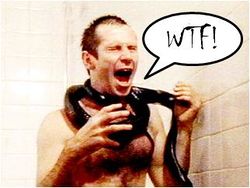
With Steve Howe continuing to make friends in Asia, and the other ex-Yes members nowhere to be seen, Squire introduced Trevor Rabin as the band's new guitarist and principle songwriter. Alan White retained his role as Chris Squire's lackey, and the pieces were now in place for a new band and a new sound. But Rabin feared that his singing was so good it would make the other virtuosos look inferior, so he made one final phone call.
When Vangelis answered the phone and immediately plugged the availability of Jon Anderson (who had learned how to turn into a bird), the new Yes was complete. The pieces were now in place for a new band and a new sound. But Rabin feared that his keyboard playing was so good it would make the other virtuosos look inferior, so he made one final phone call.
After recovering from his fear of the Mellotron, ex-ex-ex-keyboard player Tony Kaye, now a film director, agreed to return from Siberia and rejoin Yes. The pieces were now in place for a new band and a new sound. But Rabin feared that his production skills were so good that the record might not be commercial enough, so he made one final phone call to the glasses-wearing Trevor Horn, who would produce the new band. Knowing what Rick Wakeman and his new beard were capable of, they decided to leave him alone (for now at least).
Since Horn was still a camera, the band did not need to spend too much money making music videos, including the Steven Soderbergh-directed 9021Show. Ironically, "Cinema" was the album's only track for which a music video was not filmed. Kaye wanted to direct the music video for the #1 hit single "Owner of a Lonely Heart's Club Band", the riff of which Rabin had written with one hand in the bathroom (the same bathroom in which an acid trip turned Alan White into his exact opposite, a black cat). Director Kaye was camera-shy, so he called in Jethro Tull violinist Eddie "Jobber" Jobson (who had been deported from the UK in 1980) to fill his place in the video. Though Jobson wore makeup like the rest of the band in the video, Kaye refused to film his face and called in the government to deport Jobson once again when the video was finished.
Indeed, ATCO Records would be proven correct, as Yes's resulting 1983 album 90210 (named as such to attract fans who lived in Beverly Hills) would literally sell millions. This launched the group into a familiar cycle of excess and fortune that would again only last for a couple of years, where they got into a pattern of making a new album whenever their previous profits had run out. When Steve Howe heard that Yes had broken into the mainstream with 90210 and made a lot of money without him, he cried for two years until he — with the help of ex-Genesis guitarist Steve Hackett, sporting goods spokesman Phil Spalding, long-distance runner Jonathan Mover, and Max Bacon — formed a group called GTR (Gut Trevor Rabin).
Big Generator
“Someone's spilt prasāda on my Big Generator!”
Following the success of such simple music, the album that followed was equally mainstream. 1987's Big Generator, an idea thought up by Trevor Rabin as he ate beside a jacaranda tree outside French restaurant Chez Nous, was a laborious album to make. It took Yes nearly four years to build the machine itself, which was built to save time writing songs; the enormous, strange device through which they existed would produce a random series of sterile electronic sounds known formally as '80s music. This noise-generating method was much more efficient than sound-chasing, as no effort or talent was required by any member of the group. Indeed, the Big Generator was more advanced than the Soft Machine and the Van der Graaf Generator put together, as it allowed for the harmonic convergence of holy lambs. In typical '80s fashion, Big Generator was released in four different "collect-'em-all" colour schemes (yellow and pink, red and yellow, green and blue, and black and yellow), in an attempt to fleece as much profit from holy lambs fans as possible.
“Shoot high, aim low.”
Jon Anderson, believing that the blue sedan did not get them much further, grew dissatisfied with the poppy, Horn-produced, California-bound "YesWest" songs on the album and was beginning to yearn for more traditional Yes music. Wanting to see through this mask of uncertainty, he told the others about an idea for a 20-minute epic about a Khatru who climbed to the summit of Mt. Kilimanjaro and had a spiritual awakening, using only the chords of Bb Minor and F# Major Seventh (which he played on a giant didgeridoo, with an accompanying banjo that was filtered through a Leslie speaker). Rabin was less than impressed, so Anderson re-pitched the idea to some of his ex-bandmates, leading to the formation of the progressive barbershop quartet, Anderson Bruford Wakeman Howe (which featured the less-important Tony Levin on bass). The group released an uncreatively self-titled debut album in 1989, and performed a tour titled An Evening of Yes Music Minus Chris Squire.
Union
By 1991, both YesWest (WARKS?) and ABWH were becoming less and less rich, and eventually the two separate parties gave in and amalgamated in the great big orgasmic jam session that was Union (or Onion as Wakeman called it, because, as he claims, "it made me cry every time I heard it"). Continuing the vegetable culinary theme that began with Tormato, Onion is the first and only album to feature the MegaYes lineup. The advantages of having a nine-member band included more disputes, more songs, and tonnes more fat juicy ego. However, the nine members were only together during the mammoth tour that followed, during which Peter Banks was invited as a joke and then humiliated when Howe told him to get lost. The songs on the album were actually recorded as unfinished demos in two nine separate locations, under the guidance of five separate producers, and then drenched in the capable hands of some 200 underpaid Los Angeles session musicians. This was opted for instead of using the last album's technique (the random noise generator), because it now produced '90s music instead of '80s music. Producer Jonathan Elias later admitted that he did this to get back at Jon Anderson for making Elias of Sunhillow.
“He cut in front of me at a Chinese restaurant!”
Anderson had asked Squire to play bass on the ABWH tracks, but Squire did not feel like it, so Tony Levin kept his spot on those tracks. Elias found Howe and Wakeman's submitted parts to be piss poor, so he erased them from the master tapes and had session musicians overdub them. Session guitarist Jimmy "The Hun" Haun was hired to masquerade as Steve Howe and overdub his parts since they had become enemies in Asia, hence the song "Masquerade". Wakeman's parts were overdubbed by eleven separate keyboardists for some reason, even though only one would've sufficed. All in all, roughly 5% of Howe and Wakeman's parts remained on the album, as though their contributions were for nothing. Bruford and Levin wanted to celebrate the 20th anniversary of Fragile, so they included "Evensong (52 Seconds for Nothing)" on the album; however, they forgot to inform the rest of the band about this.
Onion was despised by the band members but was a huge commercial success and was at first relatively well-liked by fans, until band members told them in interviews to stop liking it because of the endless overdubs and false advertising. The reason that Onion sold so well was that Rick Wakeman bought many cassette tapes of the album, tried listening to them, and threw each one out his car window in disgust while crying. In a guest column for Rolling Stone, SNL star Eddie Murphy gave Onion two stars out of five, saying "Ogres are like Onion. They stink. They make you cry. You leave 'em out in the sun, they get all brown, start sproutin' little white hairs. Above all else, Onion has layers. Ogres have layers. They both have layers. Not errybody like onions." The album was supported by several singles - the most popular which is Rabin's anthem to paraplegics everywhere, "Lift My Cup". Less well known is the ABWH-penned "Dangerous (It Ain't Gay To Hold A Homie's Dick, He Has To Carry That Weight All Day, Mfer Ain't Hercules)". When asked about the song's name by fanzine Close To The Notes, Jon responded, "A zillion years ago, we lived on the planet Zongo. We are Zongonian. And as Zongonians do, we would go down to the seaside to watch the sun rising."
In 1992, after a few shows in Japan (where one of the two Jons was kidnapped by Kitaro), Howe became fed up with all of the turbulence and left Yes for Asia again, taking all of the other talented members with him. At one point in 1993, he and Bill Bruford played on the album Symphonic Music of Yes, thinking that they were back in Yes, but it was only the London Philharmonic Orchestra pretending to be Yes (even reusing audio of Jon's vocals from "Roundabout"). Out of sheer rage, Bill Bruford declared that he would never again join Yes. Rick Wakeman, meanwhile had committed himself to joining only when the constellations aligned on the solstice.
Yestalk
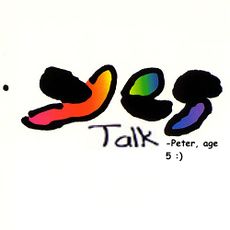
Continuing through the '90s, Trevor Rabin retained leadership of Yes, and simple songwriting was just what he required to make Steve Howe cry and wonder if he mattered in the grand scheme of things. The 90210 lineup were now free to attempt more simple songs, but even the multi-instrumentalist Rabin was struggling to come up with any hit singles. So Jon Anderson reappointed himself as the band leader, which led to a confusing concept album but one that was deemed the lesser of two evils. It was during this album that Anderson and Rabin talked to each other for the first time, bonding over their belief that Tony Kaye should only play a tiny bit on the album.
Distributed by Not-So-Victorious Music and themed around Anderson's often-incomprehensible language and general manner of speaking, 1994's Yestalk was as fun to listen to as the Queen's speech. It was also the first album to be entirely recorded digitally, onto Rabin's Macintosh hard drive, which resulted in a somewhat plasticky, sterile sound. The last song made for the album was "Walls", which Rabin had written with a Supertramp named Roger Hodgson. He ultimately regretted including the song because it did not fit the common talkative theme covered by the rest of the tracks. The fingerpainted cover artwork, which was also as pleasurable to look at as the Queen herself, was sent in to the band by 5-year-old fan Peter Max. This colourful graffito was far better than anything Roger Dean ever came up with, subtly reflecting the collective rationality of Yes at the time.
Despite its relatively successful tour (for which the songs sounded more lively than they did on the album), Yestalk was less popular than previous Rabin albums. Following the tour's conclusion, Rabin, feeling that he had achieved his endless dream with Yestalk, lamented the album's disappointing reception as an indication that it was "just not what the peon masses wanted to hear at the time." He left Yes and returned to Los Angeles, where he went on to compose soundtracks to meme movies like Kangaroo Jack and Snakes on a Plane. The name Yestalk was later adopted for an online forum where fans of the band gather to worship Rick Wakeman's hair. They are also known for their frequent pilgrimages to Yes concerts, where they attempt to touch members of the band.
Land of Rabinless Confusion
Keys to Ascension
In May 1995, as Alan White joined Oasis an hour before performing a show with them (just as he had done when he joined Yes), Jon looked through the drummer's underwear drawer (replete with ichthys-shaped tighty-whiteys). He found a napkin that had been signed on Chris Squire's drunken birthday party in 1974 by the Tales from Topographic Oceans lineup, who had agreed to reunite in 1995. Though the rest of the lineup had been joking at the time, Jon took it seriously and threatened to banish them to Siberia if they did not fulfil their promise. White agreed to balance time between Oasis and Yes as long as Anderson stayed out of his underwear drawer. Since Steve Howe had been banished from Asia for getting a couple of countries mixed up, he had no other options. He was delighted to see Trevor Rabin get kicked out of the band and reduced to making film soundtracks, as punishment for Yestalk's commercial flop. Tony Kaye argued that, with Trevor gone, he could stay in the band and play to the best of his abilities. Jon did not care, so he banished Tony to Siberia (again) for ten years, during which Kaye directed the movie American History X about Khatru supremacists. Then, in a strike of luck, Rick Wakeman made himself available once more (again).
Over the next year, the band members put the keys into their collective Yes mind, set it to ascension mode, and drove it. They recorded seven studio tracks under their independent label Yessential Records, and performed a tour consisting of Squire's three-day drunken birthday bash in one venue at the San Luis Obispo Wilderness (SLOW). These studio tracks were "Be the Jon" (disliked by all members except Jon), "Shat, That Is" (about William Shatner), "Mind Drive" (an extended, repetitive version of an XYZ demo), "Hand Prints" (a song about the smudges on Steve's guitars), "Bring the Power to Me" (written by power-hungry Jon Anderson), "Children of White" (based on an ABWH demo that had been dedicated to Alan's children Jesse and Cassi), and "Steveign Language" (a secret message between Howe and Wakeman about the lack of creativity). They released the live/studio hybrid albums Keys to Ascension in 1996 and Keyz 2: Electric Boogaloo in 1997, both of which began with live tracks from their tour setlist and ended with the aforementioned studio tracks. Though Rick had wanted the seven studio tracks to be released as a single Yes studio album with Jon's proposed title No, the record company did not heed his wishes, instead burying these tracks on the rump ends of the Keys albums, so that nobody would listen to them.
As the band continued mind-driving, Wakeman refused to turn his steering wheel in the direction in which the other band members were heading (again), causing the Yes hivemind to spin out of control (again) and enter a new, Wakeman-less state (again). Desperate times called for desperate measures (again), and replacement members were soon found, next door (again).
Open Your Eyes
Taking the advice of a fortune teller via a 1-800 number, Chris quickly got Billy, a 12-year-old boy from Nevada who was fresh off mixing Keyz 2, to join Yes to contribute a more "down-with-the-kids" sound (Spice Girls take note). After signing onto Eagle Records, a shady new record label with flappable deadlines, they recorded new songs for the album Open Your Eyes in just three weeks at Universal Garden Studios. As they were pressed for time, Billy and Squire took some Conspiracy tracks they were working on and had the other band members tack on new parts to Yesify them. One such track track, "Man in the Moon", was created to teach kids about — what else — Aiken Drum.
With Billy onboard, the new album was as youthful as it was catchy; the presence of a 23-minute "nature sound solos" epic, inordinate pop content, more love songs in a row than Big Generator, man-in-the-Moon conspiracy theories, and a paedophile keyboardist just proves how child-friendly OYE Vey Como Va was. Unfortunately, as the track "Fortune Seller" suggested, the band made a huge loss from its release. By this point the 9021Vault was empty of cash, and Yes was becoming less of an asset to their management and more of a hindrance. New recruit Igor Khoroshev helped out by financing his own keyboards (hence the use of the Stylophone), and Steve Howe, who hated sharing guitar duties with Billy, agreed to fire himself for a couple of months to save more money; the cost of the album was ultimately totalled at around £1.20. During the Manchester show, Rick Wakeman, embarrassed to be seen with Yes, would disguise himself as a son of his (of whom nobody has ever heard) after causing Igor to miss his flight to the gig as a joke.
Fueled by his annoyance at the amateur cover artwork previously seen on Yestalk, Roger Dean smattered his artistic influences all over OYE's cover. His design was a simple sunny orange Yes logo, but he enforced that the size of each jewel case should be 10 metres squared at minimum, in order to hammer home the fact that he was the band's primary artist. In the following months, every record shop in the world was clogged up with giant CDs that weren't selling, and took up lots of room. At the next G8 summit, it was agreed to launch millions of these records into outer space; the huge Yes logos have since been adopted as currency in surrounding solar systems.
The Ladder
Yes were getting pretty old by the time The Ladder was released in 1999. Howe, Anderson, Squire, and White all required medics to tour with them as heart failure was frequent. Steve Howe also died many times, and was often resurrected using cheap equipment, contributing to his "mad scientist" look. Chris Squire also was frequently mistaken for Father Christmas (his diet consisted of fourteen kilograms of Schindleria praematurus a day). It was thus down to Igor Khoroshev and Billy the Kid to guide Yes to success, and they wrote and recorded every single song on The Ladder — most notably the first track and lead single, "Homeworld (Лестница)", which ended up in a computer game whose title has since been forgotten.
The significant and memorable producer of the album, whose name I have forgotten, sadly died shortly before the release of The Ladder. It turned out that he was brutally murdered by former Yes producers Trevor Horn and Eddy "Are You Reddy Eddy?" Offord. The pair repeatedly attacked him with earlier Yes records, including one particularly gruesome copy of Relayer that was used to decapitate him. They later formed a comedy duo act known as That Horny Offord Sound, which featured impeccably-produced jokes (that weren't very funny).
Things initially seemed to be going well, with the band even performing at Billy's Halloween party at his house in Las Vegas (filmed and released as House of Yes: Live from the House of Billy). There, Billy, Igor, Steve, Chris, Jon, and Alan dressed up respectively as Frankenstein's Monster, Igor, Dr. Frankenstein, Father Christmas, Leprechaun in da 'Hood, and a generic drummer (Alan still lacked personality); Wakeman crashed the party dressed up as Count Chocula, wearing a cape again. Unfortunately, despite Billy's songwriting efforts, he was promptly fired after the album's low chart position was revealed. Chris stayed in touch with Billy, forming a Conspiracy with him to eventually overthrow Jon as the band's leader (and promising that Billy would then become Yes's lead singer if he did not go through puberty by then).
Realising they still needed a keyboardist, Yes retained Khoroshev (Rick Wakeman was busy making a bunch of forgettable solo albums as usual) for their Masterfireworks Tour of Kansas in 2000. This was the only tour during which they ever performed Igor's booming "Firework Suite" in its entirety, as well as every 15-plus-minute song that Yes had made up to that point. The Masterfireworks tour rivalled Bill Bruford's Earthworks, as well as Master P, Windworks, Waterworks, and Earth, Wind & Fire. Unfortunately, the tour was cancelled, as Khoroshev was fired from work by his masters after trying to assault two 16-year-old security guards with his own kinky fireworks.
Magnification
In 2001, the famous four congregated once more, after Rick Wakeman's decision to only be in the band once every leap year. Despite Steve Howe being older than all of the Golden Girls put together, Chris Squire still being frequently mistaken for Santa Claus, Alan White having his own business-related reality TV show, and Jon trying to reboost his career by appearing on QI (oh wait, that was his brother), the four of them still made the decision to release yet another Yes album. Doctors disagreed, recommending Magniflex brand medication; being old, the band members misheard this suggestion as an album title pitch. The XYZ demo "Can You See That We're Young?" was reimagined after getting dug up from the beach by Squire's ocean home.
The band filled their indecisive vacancy of "Yes keyboardist" with an orchestra, something that hadn't been done since 1970's Time and a Wørd (difference being, the latter actually sold well). The two albums actually feature the same orchestra (though conducted by Larry Groupié this time), continuing the theme of "Nobody who works on this album must be younger than 50 years old". Wikipedia states in its trivia section that Alan White wrote most of the song "In the Presence Of", proving that a drummer writing a song is considered trivial. Anticipating a tour, the band hired meatloaf-eating keyboardist Tom Brislin to stand on the south side of the stage and do nothing unless the entire orchestra died. Only half of them would end up dying.
Magnification received a lukewarm reception from critics, and sold poorly unlike its sister orchestral concoction Time and a Wørd. The album being released the same day as 9/11 perhaps diverted the public's attention away from Yes and over to other tantalising subjects, such as Nickelback's new album Silver Side Up. It would ultimately be the one last try at success by Yes's classic lineup (sans Wakeman); more tours have since followed with many different members of Yes in various combinations that really aren't that interesting.
In the present of
Anderson's departure and replacement

In 2008, a 40th anniversary tour of the south side of the U.S. titled Close to the Edge and Back was cancelled when Anderson's respiratory problems kept him from going off to look for America. Yes replaced him with Belgian digital unicorn Benoît David (how they found him is a Mystery). David is a clone of Jon; his singing voice was sampled from the Yes singer and wired into his voicebox. However, due to an administrative mistake, Benoît became a full-time member of the band. Squire would later claim that time travellers from the year 4007 had told him that he was supposed to recruit David, and also merge with Steve Hackett into a being called Squackett.
“When I found out that they were touring without me — and with a copycat clone who looks like me, no less — I was very disappointed.”
“When ABWH played Yes music without me, that was Jon's way of getting back at me for doing Drama without him. So I saw this as a chance to one-up Jon. I guess he didn't realise that this was a joke. I should probably tell him. Then again, it wouldn't be as funny, so we'll just go along with it until he figures it out.”
Anderson was less than pleased about this, but fans held out hope that his return was imminent. In October he posted on his website a stream of insults directed at the current lineup, and for the first time ever, what he said made perfect sense. Jon said that he disliked that the lineup were touring as Yes, not realising that they were actually billing themselves as "Steve Howe, Chris Squire & Alan White of Yes Introducing Oliver Wakeman and Benoît David". Indeed, Rick Wakeman had also decided to tour with Yes again, under the deceptive title Oliver Wakeman. Many foolish people believed that this was Rick's son due to his apparent age, but Wakeman insisted that it was him and that he was feeling younger than ever, having been treated with age-reducing bio-mechanical implant surgery. Wakey's experiences with Yes over the years would be recorded and released as Past, Present and Future.
“Aliens are only us from the future.”
Though Anderson felt better in 2009, Squire wanted to get back at him for doing ABWH without him 20 years earlier. He said that he would let Jon return if he realised that he was only joking around; Jon did not catch on. It was during this year that Yes toured Asia, making Steve Howe (whose banishment from the continent had been lifted) play half of the show before the rest of the band went onstage. Howe was even more pissed off the next year, when Trevor Rabin (who had been contacted by Yes management to replace Howe, since they had expected him to die at this point) tried to sabotage Yes by performing "Owner of a Lonely Heart" with them at the Greek Theatre in 2010. Fans who missed the Tales lineup started saying "Three-fifths Yes is not Yes!", not realising that, by that logic, Fragile and Close to the Edge should not be considered Yes either since they feature 3/5ths of the original lineup, and that the Tales lineup should be considered 2/5ths Yes. It was also controversial because it brought to mind the Three-Fifths Compromise.
Fly from Here
A new album with Yes's In the Present tour lineup was planned, with its 2011 release relying upon Steve Howe's ability to stay alive until then. The popular bookkeeper chain Ladbrokes allowed customers to place bets on this, with odds of 3:1. Now under the label Space, the Final Frontiers Records, Nü the band set forth recording Fly from Here. Roger Dean, who had been starving in the 14 years since he reached his creative peak designing the cover for Open Your Eyes, was contacted by Faux Yes to make a new album cover, which depicted a green eagle flying through an alien landscape forest.
Too lazy to make a whole album of new songs, Yes dusted off their back-catalog and uncovered formless memories lingering: "We Can Fly from Here" (an outtake from Drama) and "Death on a Film Set" (a demo by The Buggles that predicted the death of Trevor Horn). The members of Yes claimed that everything was recorded "in the present", even crediting Horn's vocals to David. Since hardcore fans had already known of "We Can Fly from Here" via bootlegs, the band refrained from using the whole title and split the phrase into two separate phrases on the tracklist. To further throw off suspicion, they brought in Geoff Downes all the way from Asia (where he had found his hands) to contribute to tracks 7 and 11. They also got Trevor Horn to appear in a music video for "We Can Fly (Except Steve)", in which he flew sky high through the clouds and carried a rear-view mirror (he was still a camera). During the shoot, Jon Anderson a man in a white hovercar killed the video star, who had not read that objects in the mirror were closer than they appeared. Fly from Here was released in LP format, with "Bumpy Ride" being a track that spanned an entire side (and a bumpy one, at that).
After guest-recording one new track, Wakeman told the group that it was their hour of need for Jon Anderson; Squire's response: "You are the weakest link. Goodbye." Wakeman would go off to marry a fourth wife, his sights set on surpassing the record of The Six Wives of Henry VIII. Steve Howe contributed the solo track "Solitaire" to Fly from Here, claiming that it was tradition to feature one of his solo studio tracks on a Yes album once every 20 years since 1971. In truth, he had no room for it on his solo album Time Is What I Don't Have, and he was not sure if he would live long enough to put it on another solo album.
“What have I become? What am I running away from? I used to see things in a very different way. What am I to do? I have changed my point of view. I was lost. Now I've found myself in you!”
“Armies of angels are starting to form. Take me away at the break of the dawn. Take me away!”
Jon Anderson said that the album sounded dated, and he was right. Realising that Benoît David could not write for shit, Yes invited Anderson back. Jon accepted the invitation (designed by Roger Dean), but this turned out to be a ruse, as Yes performed a ritual that combined Anderson and David into a being who was both energetic and experienced; they named this hybrid "Jon Davison". Unfortunately due to David's mere mortal body being too weak to handle Jon's alien voice, the fusion was left unable to actually sing; so far, this has gone unnoticed by the band. Yes then announced that they were going to perform three albums on tour in 2013. Though the plan was to make three new studio albums to earn a ton of money quickly, Davison needed time to adjust to his new body and new skills (he had believed that he was Rick Wakeman, even going as far as sculpting a hammer out of glass to imitate the Nordic god of thunder). Therefore, they decided to play three older albums instead: The Yes Albatross, Close to the Edge, and Going for the One.
A day in-between two of the shows, Steve Howe (who had recently ended his residency in Asia, despite Downes's wishes) caused heard about the death of Yes's original guitarist Peter Banks, who had planned on playing material from Yes's first two albums with a band creatively named Affirmative. With Banks's death, Squire cancelled plans for SuperMegaYes to perform a 45th anniversary Broadway show titled The Holy Lamb Cries Out on Broadway.
Heaven & Earth
With his experience performing the old material, Davison felt ready to record in the studio with Yes, and in 2014, they released a new album titled Heaven & Earth. Though some would believe again that Yes were referencing their previous song "We Have Heaven", Squire set the record straight (though he did not set the album record itself straight) by explaining that the title had to do with the album's "heavenly" and "earthy" production, aimed at those who were turned off by the gritty, threatening sound of previous Yessongs like "Circus of Heaven", "Man in the Moon", and "Lightning Strikes". The album was originally going to be titled Levin & Dearth, referencing the ABWH bassist's lack of style.
The album was produced by Roy Thomas Baker, who previously produced the 1979–80 Paris sessions (which did not yield an album). He had bet during the Paris sessions that the band would break up and never reunite, but that if they were still around 34 years later, he would produce their new album for free and bake them another cake. Yes revisited the motif of reusing old material as they did on Fly from Here, basing "Dancing Through the Light of the Golden Rock of Ages" on material from the aforementioned Paris sessions, but they hoped that nobody would notice. Davison and Downes had come up with a prog epic during the sessions for the album, but they decided to shelve it because they were running out of ideas and wanted to give people a reason to buy another album. The album was mixed by Billy the Kid from Nevada, now an adult, who by that point had explored The Unknown with Squire, made Tony Kaye his bitch by CIRCA: 2007, produced a ton of tribute albums to proclaim his love for other bands without having to come up with new material, and pondered the Mystery (Benoît David's old band) with Captain Kirk. The mix ended up sounding weak and muddled; Billy claims it was because he came in late to the project, but fans suspect it was by Billy's design. None of these creative choices made Heaven & Earth any more likeable. Many believe that this is partially due to the fact that the producer was Roy Thomas Baker, who previously produced the 1979-80 Paris sessions (which did not yield an album).
Heaven & Earth was sponsored by Subway; lost in translation, Roger Dean designed Yes graffiti on actual subway walls instead of Subway stores themselves. As a marketing strategy, the band released minute-and-a-half-long teaser audio clips of songs. While their intention was to make this method a Big Generator of interest, these clips actually put people off of the album. Panned by fans and critics alike for its sheer boredom, the album has been described as a desperate attempt to get fans to believe (again) in the current lineup. As a result, the band only played three tracks from the album on the subsequent tour; they did, however, perform Fragile and Close to the Edge for the millionth time, more or less in their entirety (they had forgotten yesterdays about the "TELL THE MOONDOG, TELL THE MARCH HARE" reprise of "We Have Heaven" after "Heart of the Sunrise"). Yes members have said that they had prepared for the struggle against "Apocalypse", the most complex section of "And Me And I".
“I used to believe in a Yes with Jon A., not me.”
“Please, we need you to believe again.”
“We all know the rules of the name. Us fools, still we play the same, as if our days remain.”
“Heaven is an unknown place of no particular destination as far as anybody knows.”
“It's not like I lost any money; the album didn't really sell.”
“Beg, steal, rob, run, hide.”
Death of Chris Squire and schisms
After the chart success of Heaven & Earth (owing to Jon Davison using his elf powers to play the album on every radio station), Yes wanted to take a break from touring. However, they ended up playing over four-point-four billion more shows in 2014 alone, and played a further sixty-five million shows in 2015 before the Levin & Dearth tour was finally over. In this time, they released a live album (which once again had anaemic mixing from a mysterious engineer), and a boxset containing seven concerts back from when they still had fans. All seven discs had the exact same songs, just played at different times at different venues. It didn't sell. Undermining the band, Billy also announced the day before the 45th anniversary of Yes's debut album that he and Tony Kaye were working with a reformed Mabel Greer's Toyshop, and that they would finally release their long-awaited debut album. The few living MGT purists called the new lineup "Maybe Greer's Toyshop", since only two of the five members were from the original lineup.
While the rest of the band was ready to return to the studio to record the tracks that they'd (intentionally) left off the last album, news of Squire's diagnosis with acute erythroid leukemia was made public. Fearing for his health, Squire announced he would be taking leave from the band. His condition deteriorated soon after, and he passed away on 27 June 2015 in his Phoenix, Arizona home. As the elderly musician's body shut down, Chris evolved into a Schindleria praematurus, and with his final breath swam into the river that flows known as time — a river of which where it ends, nobody knows. Alan White realised that with Squire dead, he could now make decisions for himself. Soon afterwards, White announced that Yes would be continuing with Billy in the late Chris Squire's place. Following a failed petition on Change.org to get Yes to change their name to "Maybe", and with Squire and Anderson (the last remaining members of the original Yes lineup) gone, the remaining sensible Yes fans decided that Yes was no more.
“Absolutely, we're moving ahead. We're gonna do it for the money. Money so high, money so low; money to count, money to go.”
“I'd also like to add that my head is in EXACTLY the right place concerning matters of performing Yes music, as I have shown sufficient respect & love of Yes music not to have to apologise or negotiate with anyone.”
Little did Alan know that Billy would backstab him in 2016, so that he could replace each band member one-by-one with his less-talented friends. Though Alan survived and got back surgery, he was still replaced by Jay Schellen for a bit, during a tour in which the lineup performed all of Drama and just sides one and four of Tales from Topographic Oceans (since Steve was too ancient to remember sides two and three). Alan returned during the Japanese tour, with Jay still on standby in case another attempted assault actually succeeded.
“They just want to go on the road and make money. They don't care for the integrity of the band. I feel they have let a lot of fans down. They're just in it for the money.”
None of this sat well with Jealous Jon, who could sense what was going on. Using his magical elven powers, he was able to keep touring with this lineup as Jon Davison to keep an eye on Billy and also project his original Jon Anderson form, which reunited with Rabin and Wakeman to form the "holy Yes trinity" of Wakeman Anderson Rabin (WAR), who hoped to smite Yes in the Great Prog War. Initially, they wanted to recruit Bill Bruford and Tony Levin and call themselves BRAWL, but they found out that Levin had "retired" Bruford for not adding Levin's name to ABWH's name 20 years earlier. The concept for WAR had been gestating since 2010; though they blamed the project's delays on scheduling conflicts, the truth is that they had not thought of any new music together.
WAR's tour was advertised as An Evening of Yes Music and More, playing relaxing teatime fireplace renditions of classic Yes songs, with the "more" simply being the ABWH song "The Eating of Meat" sprinkled in for flavouring. Jon had said prior to the tour that they would also perform "Mind Drive" and songs from Yestalk, but this was just a ruse to lure in fans. Playing with them on-tour were bassist Lee Pomeroy and drummer Lou Molino III, both of whom nobody has ever heard of before. In a Rolling Stone interview, Jon claimed to be the sole writer of all the Yes lyrics, which upset Steve because he actually had written some lyrics for the band. During their 2017 tour of Europe, WAR started calling themselves Yes Featuring Wakeman, Anderson, and Rabin. They did not include Pomeroy and Molino's names because it would have looked too long, and they would've lost the cool WAR acronym.
49th Anniversary Re-Onion
After twenty-three denied nominations, Yes were finally selected in 2017 to be inducted into the Rock and Roll Hall of Shame, which just wanted to give Steve Howe a present the day before his 70th birthday (eerily, it would also be the 49th anniversary of when Jon met Chris). Rather than have every member who contributed to Yes music inducted, the Hall decided to only induct Anderson, Bruford, Howe, Kaye, Rabin, Squire, Wakeman, and White. A Change.org petition to have original guitarist Peter Banks inducted as well was started, but nobody signed it since the Hall only cares about famous band members who've died.
Grumpy Old Rick hated the Hall of Shame, and was not planning on attending the induction ceremony since Chris was not alive for it. However, he changed his mind when he realised that it could be his chance to tell dirty jokes in front of an audience; ironically, Wakeman's joke-mugging took up so much time that Chris's wife and daughter were not able to say anything about him. Bill Bruford didn't deliver a speech either, but that was just because he didn't give a shit about Yes anymore. Tony Kaye couldn't make it to the ceremony since bouncers were mistakenly told that comedian "Peter Kay" was being inducted, and they didn't realize that Kaye and Kay were actually two separate individuals with similar surnames.
Anderson, Howe, Rabin, Wakeman, and White performed "Roundabout" with Geddy Lee on bass since he was so big of a fan that he, as well as fellow Rush member Alex Lifeson, delivered a nice speech about Yes that disregarded all the drama of the band's history. They also performed "Owner of a Lonely Heart" with Steve reluctantly on bass; Jon, Trevor, and Rick had requested that Billy the Kid not play bass with them onstage, since they knew he egotistically wanted to replace John Wetton in Asia and Chris Squire in Yes. This made Billy so upset that he, along with Geoff, got drunk and crashed a Patrick Moraz piano concert nearby to play "The Smile Has Left Your Eyes" the night before the ceremony. Billy is currently working on a Chris Squire tribute album in an effort to cover the scent, and a John Wetton tribute album will surely follow for the same reasons.
“I AM prog rock!”
“I AM Peter Kay!”
“...”
The King Crimson Touring-Only Curse
After being unsuccessful at the merging two Yeses together once again, Jon has announced that he will record an album with himself and title it Jonion. He and the rest of WAR also planned on recording a new album, which might've gotten made within the next several years, but the group ultimately broke up in 2018 due to continued laziness.
Meanwhile, the Howe-led Yes lineup announced their 2017 Yestival tour, during which they performed one song from each of just their first ten studio albums (Yes to Drama) since Howe still hates Rabin. In 2018, they headlined the Crusie to the Edge tour on cruise ships packed with flabby old boomers and pensioners. A similar tour with this type of setlist, highlighting the best bits of Yes's history, took place during the band's 50th anniversary from 2018 to 2019, though Steve worried that Billy might backstab him and replace him with Jimmy Haun from Onion before then. The tour included cheesy guest cameos from Tony Kaye, Trevor Horn, Tom Brislin, and Patrick Moraz, akin to the Simpsons randomly meeting Chief Wiggum in Chief Wiggum P.I.. Also in 2019, Yes headlined the Royal Family Affair Tour across the U.S., with a lineup featuring other bloated prog artist like Asia, John Lodge, and Carl Palmer's ELP Legacy feat. The Crazy World of Arthur Brown. Craving more money, the band re-released Fly from Here at this time, replacing Benoît David's vocals with Trevor Horn's since the public had been convinced that Horn had sung David's vocals in the first place. As if this weren't enough, the band also squeezed out From a Page, an album featuring Oliver Wakeman's table scraps from the Fly from Here sessions.
Yes had planned to resume touring in 2020, during which they would perform cult classic Relayer in its entirety. Unfortunately, the tour was postponed due to the COVID-19 pandemic. Jon Davison had confirmed that the band has started to develop material for a new album, be it good or bad, whose working title is Long Social Distancing Runaround. It is expected to be recorded and stitched together remotely via Protools, and released sometime in the future. Alan White is the only member of Yes who is yet to be fired, having stayed part of the band throughout most of its line-ups, incarnations, re-incarnations, and time-space continuums since 1972.
The Yest For Ques
In November 2019, Steve Howe was looking through his closet where he kept the remains of the bassists he’s killed, when he discovered an old decrepit scroll - not unlike his own appearance. Once he opened it, he shrieked in surprise, and immediately showed it to his bandmates, declaring that it was a map to buried treasure. He then demanded they board a plane at once to follow it on The Quest. The band members were reported as being confused, as the scroll was not a map but in fact was an image of Steve Howe’s face, but complied with his request as they didn’t want to be shoved into his closet.
“I've got an idea, been on my mind. I'll share it with you, and see what we'll find.”
Eventually, on the last plane out the band flew to Asia, where Steve Howe claimed The Quest would take them. Once they landed, they were dragged by their unwell bandmate through jungles, killed several times by sexy women, and crossed a peculiar bridge the locals claimed to have been seen by a khatru named Snowflower Elder. Sadly, in their Quest the band discovered that it was not Snowflower Elder who had crossed it, but obscure composer Francis Monkman, who they let join their Quest on the condition that he not sue them for copyright infringement. Their expedition can be seen recorded here - band members Steve Howe and Geoff Downes are visible, along with some Asian natives. Sadly, the other band members were not available to be filmed, as they were busy being mauled by greyscale snakes and Steve Howe.
After several months of travelling along the western edge of Asia, the band finally found what the so-called map supposedly led to. Sadly, all they found was a CD labelled Yes - The Quest, which upon playing they found nothing of value on. Nearby was also found another CD, around 0.375x the size of the first one, which was also 0.375x the quality. Steve, However, was for some reason ecstatic to find these and ran off with the two CDs minus the five men. Once back in his homeland of Hell, he immediately released it to the public, to which the public responded the exact same way as the rest of the band.
“Leave well alone.”
Luckily, this response didn’t bother Steve, as he had 6 songs on the album written by him. The Quest is so far the most recent release from Yes. They have yet to go on the Relayer tour as promised, as the other 4 band members are still stuck in Asia.


